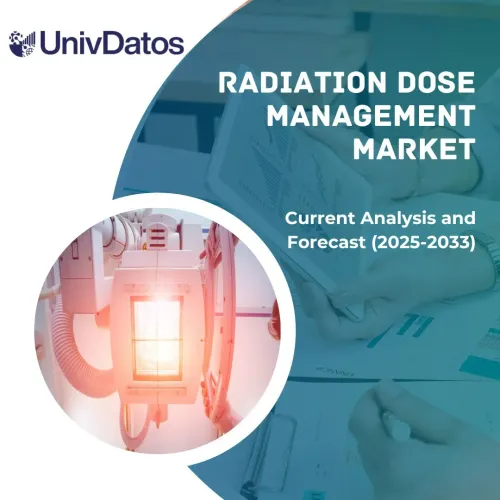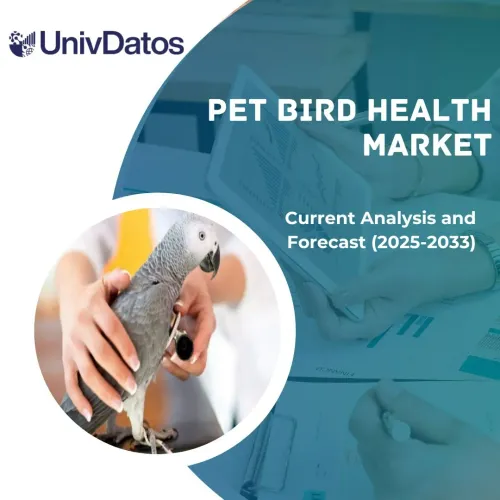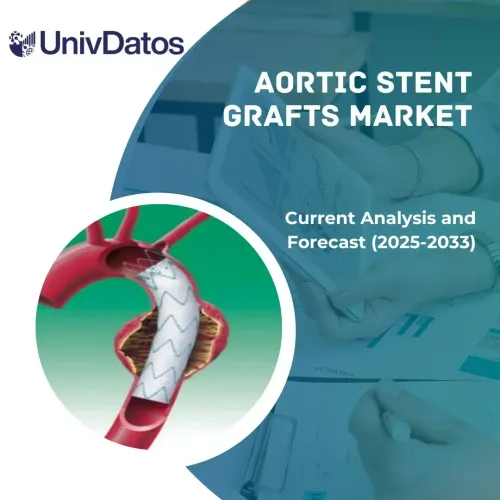- Home
- About Us
- Industry
- Services
- Reading
- Contact Us
Exoskeleton Market: Current Analysis and Forecast (2021-2027)
Emphasis on Type (Powered, Passive); Body Part Type (Lower Body, Upper Body, Full body); Mobility (Mobile Exoskeleton, Stationary Exoskeleton); End User (Healthcare, Military, Industrial, Others); Region/Country (North America (US, Canada, Rest of North America); Europe (Germany, UK, France, Italy, Spain, Rest of Europe); Asia-Pacific (China, India, Japan, South Korea, Rest of Asia-Pacific); and Rest of World)
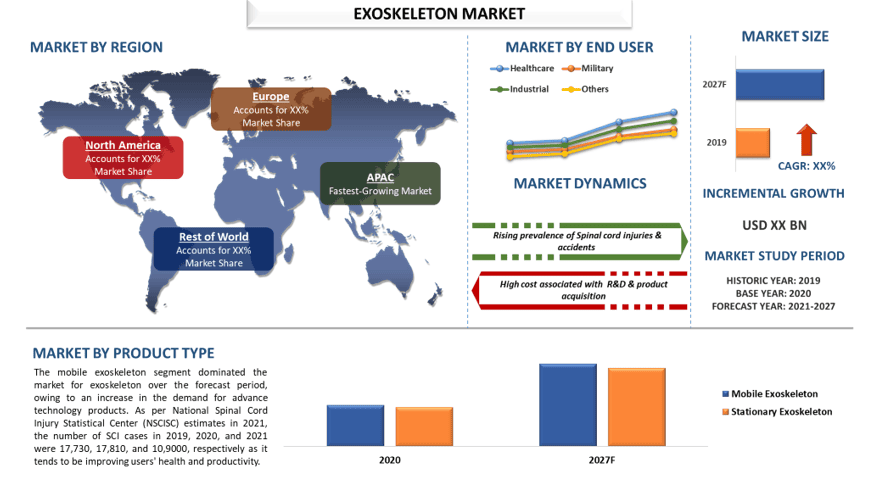
The exoskeleton market is anticipated display a CAGR significant growth of around 35% over the forecast period (2021-2027). The global exoskeleton market is expected to witness robust growth mainly due to the increase in the rising incidence rate of Spinal Cord Injuries (SCIs) with increasing falls, motor vehicle accidents (automobiles, motorcycles, sports injuries, and diving accidents which also leads to change in your brain which changes the muscle acceptance, especially among the disabled individuals with spinal cord injury population. Exoskeletons are robotic structures that humans can wear to boost their strength and mobility. As per the World Health Organization’s data estimates published in February 2021, approximately 1.71 billion individuals across the globe suffer from musculoskeletal disorders. Therefore, the constantly evolving exoskeleton industry is driving market players to devise innovative product development strategies to boost the adoption rate and activate the market revenue.
The ongoing COVID-19 pandemic across the world has had a tremendous impact on different spectra of society, the market for exoskeleton no less. The exoskeleton market faced a negative impact due to the lockdown there is a temporary shutdown of rehabilitation centers, and there has been a huge decline in healthcare. Due to this, there has been a positive impact on the negative sales and supply chains of numerous sectors, particularly during the first two quarters of the year 2020. This has adversely affected the trade of Exoskeleton products due to the high demand and widespread financial distress.
Insights Presented in the Report
“Amongst Mobility, Mobile Exoskeleton segment dominated the market in 2020”
Based on mobility, the exoskeleton market is segmented into a mobile exoskeleton, a stationary exoskeleton. In 2020, mobile exoskeleton dominated the market and is expected to maintain its dominance throughout the forecast period. This is mainly due to the rising demand for industrial & military exoskeletons to support and provide free body movement. The stationary exoskeleton is a medication used in the management and treatment to power hip and knee movement to support individuals with spinal cord injuries to stand and walk.
“Amongst End User, Healthcare category to witness fastest growth rate”
Based on end user, the market is bifurcated into healthcare, military, industrial, and others. Among these, the healthcare category is expected to witness robust growth during the forecast period. The exoskeleton frames have developed in numerous ways and according to different machines and robots’ exoskeletons in each part of the world. Moreover, growing technology in developing countries of the world and the entry of various tech start-ups in the sector are further fueling growth in the market. For instance, in April 2016, Ekso Bionics received U.S. FDA approval for clinical use of Ekso GT Robotic which was widely used in rehabilitation centers in treating patients with spinal cord injuries and hemiplegia.
“North America will Dominate the Market During the Forecast Period”
For a better understanding of the demand of the Exoskeleton market, the market is analyzed for major regions including North America (US, Canada, Rest of North America); Europe (Germany, UK, France, Italy, Rest of Europe); Asia-Pacific (China, India, Japan, South Korea, Rest of Asia-Pacific); and Rest of World. Currently, North America dominates the market; however, Asia-Pacific is expected to witness the highest CAGR growth owing to rising healthcare expenditure in countries such as China, India, and other developing Asian countries. Some of the major players operating in the market include Cyberdyne, Hocoma, ReWalk Robotics, Ekso Bionics, LockHeed Martin, Parker Hannifin, Interactive Motion Technologies, Panasonic, Myomo, B-TEMIA Inc.
Reasons to buy this report:
- The study includes market sizing and forecasting analysis validated by authenticated key industry experts
- The report presents a quick review of overall industry performance at one glance
- The report covers an in-depth analysis of prominent industry peers with a primary focus on key business financials, product portfolio, expansion strategies, and recent developments
- Detailed examination of drivers, restraints, key trends, and opportunities prevailing in the industry
- The study comprehensively covers the market across different segments
- Deep dive regional level analysis of the industry
Customization Options:
The exoskeleton market can further be customized as per the requirement or any other market segment. Besides this, UMI understands that you may have your own business needs, hence feel free to connect with us to get a report that completely suits your requirements.
Table of Content
Analyzing the historical market, estimating the current market, and forecasting the future of the exoskeleton market were the three major steps undertaken to create and analyze the demand and sales of exoskeletons across major regions globally. Exhaustive secondary research was conducted to collect the historical market numbers and estimate the current market size. Secondly, to validate these insights, numerous findings and assumptions were taken into consideration. Moreover, exhaustive primary interviews were conducted, with industry experts across the value chain of the industry. Post assumption and validation of market numbers through primary interviews, we employed a bottom-up approach to forecast the complete market size. Thereafter, market breakdown and data triangulation methods were adopted to estimate and analyze the market size of segments and sub-segments of the industry pertains to. The detailed methodology is explained below.
Seek More Details About Research Methodology
Analysis of Historical Market Size
Step 1: In-Depth Study of Secondary Sources:
A detailed secondary study was conducted to obtain the historical market size of the Exoskeleton through company internal sources such as annual reports & financial statements, performance presentations, press releases, etc., and external sources including journals, news & articles, government publications, competitor publications, sector reports, third-party database, and other credible publications.
Step 2: Market Segmentation:
After obtaining the historical market size of the exoskeleton, we conducted a detailed secondary analysis to gather historical market insights and share for different segments & sub-segments for major regions. Major segments included in the report are type, body part type, mobility, and end-user. Further regional level analyses were conducted to evaluate the overall demand for Exoskeleton in a global context.
Step 3: Factor Analysis:
After acquiring the historical market size of different segments and sub-segments, we conducted a detailed factor analysis to estimate the current market size. Further, we conducted factor analysis using dependent and independent variables such as industry trends, product application, understanding of consumer demands, competitive landscape, brand positioning, and pricing analysis. Historical trends and their year-on-year impact on the market size and share were analyzed. Demand and supply-side scenarios were also thoroughly studied.
Current Market Size Estimate & Forecast
Current Market Sizing: Based on actionable insights from the above 3 steps, we arrived at the current market size, key players in the market, and market shares of the segments and company. All the required percentage split and market breakdowns were determined using the above-mentioned secondary approach and were verified through primary interviews.
Estimation & Forecasting: For market estimation and forecast, weights were assigned to different factors including drivers & trends, restraints, and opportunities available for the stakeholders. After analyzing these factors, relevant forecasting techniques i.e., the bottom-up approach were applied to arrive at the market forecast to 2027 for different segments and subsegments across the major regions globally. The research methodology adopted to estimate the market size encompasses:
- The industry’s market size, in terms of value (US$) and the demand for Exoskeleton across the major regions globally
- All percentage shares, splits, and breakdowns of market segments and sub-segments
- Key players in the Exoskeleton market in terms of products offered. Also, the growth strategies adopted by these players to compete in the fast-growing market.
Market Size and Share Validation
Primary Research: In-depth interviews were conducted with the Key Opinion Leaders (KOLs) including Top Level Executives (CXO/VPs, Sales Head, Marketing Head, Operational Head, Regional Head, Country Head, etc.) across major countries. Primary research findings were then summarized, and statistical analysis was performed to prove the stated hypothesis. Inputs from primary research were consolidated with secondary findings, hence turning information into actionable insights.
Split of Primary Participants in Different Regions
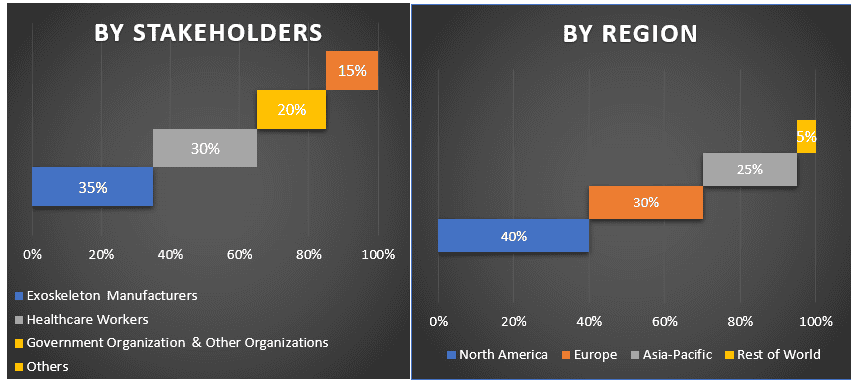
Market Engineering
The data triangulation technique was employed to complete the overall market estimation and to arrive at precise statistical numbers for each segment and sub-segment of the Exoskeleton market. Data was split into several segments & sub-segments post studying various parameters and trends in the areas of types, body part type, mobility, end-user, and region.
The main objective of the Exoskeleton Market Study
The current & future market trends of the exoskeleton market are pinpointed in the study. Investors can gain strategic insights to base their discretion for investments on the qualitative and quantitative analysis performed in the study. Current and future market trends would determine the overall attractiveness of the market at a regional level, providing a platform for the industrial participant to exploit the untapped market to benefit as a first-mover advantage. Other quantitative goals of the studies include:
- Analyze the current and forecast market size of the exoskeleton in terms of value (USD). Also, analyze the current and forecast market size of different segments and sub-segments of the industry
- Segments in the study include types, body part type, mobility, end user, and region
- Defined analysis of the regulatory framework for the exoskeleton industry
- Analyze the value chain involved with the presence of various intermediaries, along with analyzing customer and competitor behaviors pertaining to the industry
- Analyze the current and forecast market size of the exoskeleton across the globe. Major regions analyzed in the report include North America (US, Canada, Rest of North America); Europe (Germany, UK, France, Italy, Rest of Europe); Asia-Pacific (China, India, Japan, South Korea, Rest of Asia-Pacific); and Rest of World. Define and analyze the competitive landscape of the Exoskeleton sector and the growth strategies adopted by the market players to sustain in the fast-growing market
Deep dive regional level analysis of the industry
Related Reports
Customers who bought this item also bought

